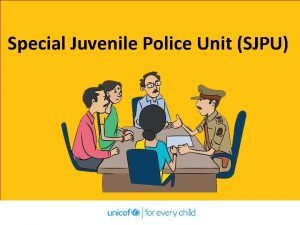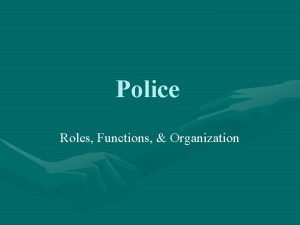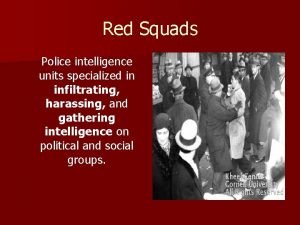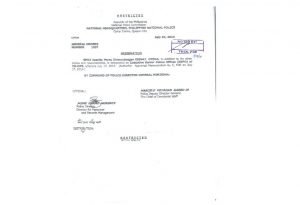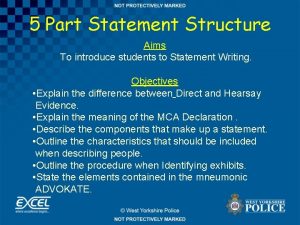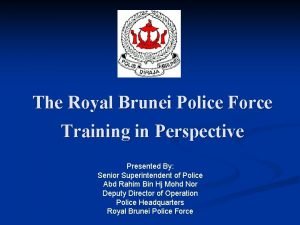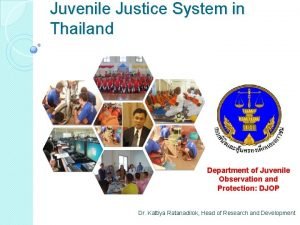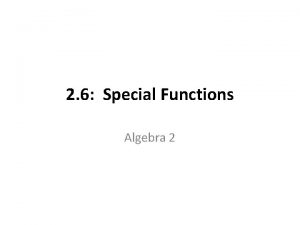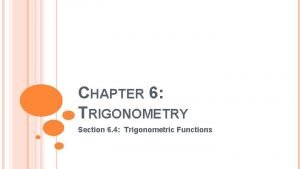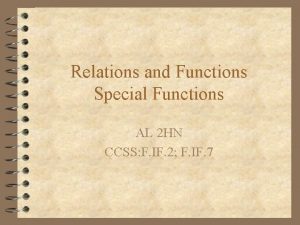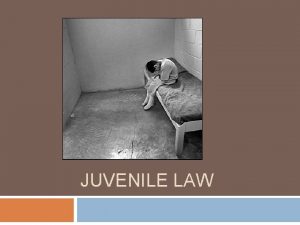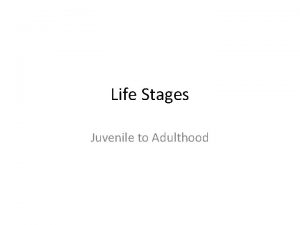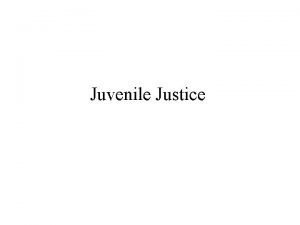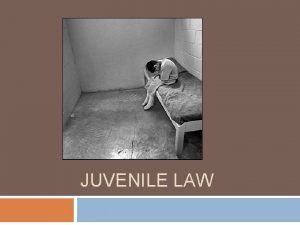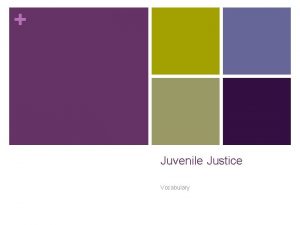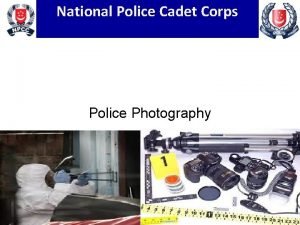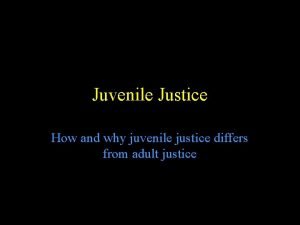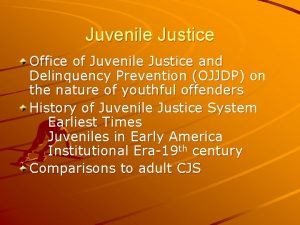Special Juvenile Police Unit SJPU Structure and functions


















- Slides: 18

Special Juvenile Police Unit (SJPU)

Structure and functions of SJPU Definition “Special Juvenile police unit” means a unit of the police force of a district or city or, as the case may be, any other police unit like railway police, dealing with children and designated as such for handling children under section 107 (Section 2 (55), JJ Act, 2015)

Overall Functions of the SJPU (Section 10, JJ Act, 2015; Rule 86, JJ Model Rules, 2016) • To coordinate all functions of police related to children. • As soon as a CCL is apprehended the CWPO/SJPU shall produce the child before the Juvenile Justice Board (JJB) within 24 hours and inform the parents. • The SJPU will work in close co-ordination with the District Child Protection Unit (DCPU), the JJB and the CWC in the matters concerning the welfare of children within its jurisdiction. • The SJPU may coordinate with the District Legal Services Authority to provide legal aid to children.

Group work and discussion «Activity 1: Group work and discussion Methodology: • Group work • Exercise - e. g. Administration of Simple Questionnaires/ True-False Exercise etc. Group Work Objectives: • To help participants understand assess the individual's role and responsibilities. • To help participants understand that their first step can decide the future of the case. • To help participants understand steps in dealing with a child in a specific difficult situation and circumstance.

Case Studies for Group Work 1 2 Question for discussion in the groups - What will be the role of Police in dealing with various kinds of cases? Give details of all steps taken by Police? Two girls Rani (14 year old) and Sunita (16 year old) who were involved in prostitution were found by Police during a raid at a red light area at 5 O'clock in the evening. During the raid, police also found Sundri (30 year old) with two children (2 year and 8 years old), Meena (21 years old) and Deepa (45 year). A beat officer found a new born baby in a dustbin during a visit to his beat area early in the morning.

Case Studies for Group Work 3 4 A common man calls up Police station and gives specific complaints about a domestic child labour of 12 years of age being mercilessly beaten up at a particular address. But he does not want to disclose his identity. 14 -year-old Kumari from Vadodara is married off by her father to a 40 year old man from Ahmedabad. The father received Rs. 20, 000 for giving away the daughter in marriage. Lala, a friend of the father helps facilitate the transportation and receives money from the bridegroom for this service. After marriage, Kumari never gets to visit her parents and all ties are cut off. She continues to live in Valsad with her husband.

Case Studies for Group Work 5 6 Case 5 - 2 -month-old Yamuna was the 7 th child born to an impoverished family in Banaskantha, Gujarat. A childless couple Kishan and Sejal from Ahmedabad wanted to adopt a healthy baby and approached Hari a native from the same village. Hari used to run an orphanage and facilitated the adoption of orphans to interested family. Hari paid Yamuna's family a sum of rupees two thousand then sold her to Kishan and Sejal for a sum of rupees twenty thousand. Case 6 - Sarita, 15 years of age, is working as a full time domestic worker in Gujarat. She hails from a village in Jharkhand. She was offered this job by a placement/recruitment agency in Gujarat, which has its branches in Jharkhand as well. She has not been paid any salary since she joined work and whenever she asks for the money due to her, she is severely beaten up by her employer. Moreover, her employers do not allow to her leave the house nor write to her family. Though she wants to return home, she is forced to stay back.

Activity: True or False rapid fire Exercise Statements: • 14 years is the age of child as per the Juvenile Labour Act. True/False • It is mandatory to produce a Child in Need of Care and Production before the Child Welfare Committee. True/False • 14 years is the age of child as per Juvenile Justice Care and Protection of Children) Act, 2015. True/False • After rescue of the child labour, child is supposed to be produced before Juvenile Justice Board. True/False • 1098 is the toll free no. of child line. True/False • Bonded labour and child labour have the same meaning. True/ False • Bonded Labour is a cognizable offence. True/False • It is mandatory to produce every child before the Child Welfare Committee. True/False • Children home and Observation Home both are meant for Child in Need of Care and Protection. True/False • If police finds a new born child in a dustbin, he can give the child to any good family which is willing to bring up the child. True/False • Police has no role in dealing with the issue of child labour. True/False • Police cannot make any complaint against those employing child labour. True/False

Case Studies for group work Case Study 1 Manjari is a six year old girl, living in a resettlement colony in a Metro City like Delhi. She works as a rag-picker and helps her family with that money. Manjari's father is alcoholic. One day, her father beat her up and threw her out of the house demanding money for alcohol. Fearful, Manjari could only think of stealing as a source of managing some quick money. Unfortunately she was caught by the guard outside the house that she entered to steal. The police was called and she was handed over to them.

Case Studies for group work Questions to guide the Group Discussion Is there any specific law in India for children like Manjari? How does this law treat a child like Manjari? Is Manjari a child offender/child? Which are the two categories of children that the Juvenile Justice law deals with? • Who is the responsible authority in this case, what is its role and where is it located? • •

Case Studies for group work Case Study 2 Rani (age 14 years), Sunita (16 years), Sundari (30 years) her two kids (2 years and 8 years), Meena (21 years) and Deepa (45 Years) were found by the police during a raid in the red-light area at 10: 00 pm, when prostitution was being carried out.

Case Studies for group work Questions to guide the Group Discussion • What should the police do in such a case? • Are the persons found supposed to be rescued or should they be caught by the police? • Under which law(s) can the police take action in this case? • Where should the police take them after the raid? • Can they be kept in a police station? • Is there a need for a medical examination of the persons found/rescued/ caught during the raid? • What kind of judicial proceedings will be required for the persons involved in a case like this and where should such persons be produced for initiating judicial proceedings?

Case Studies for group work Case Study 3 Raju (10 -12 Years) and Mangal (18 -19 years) are caught by the police in a case of theft at 4. 00 pm. While Mangal is a street child and his family lives in some other state, Raju lives with his family in a very low middle-class locality in the same area.

Case Studies for group work Questions to guide the Group Discussion • Are Raju and Mangal criminals? • How does the Juvenile Justice Act of 2015 define a child who is alleged to have committed an offence and why? • Why was there a need for a separate law instead of the Cr. PC to deal with children alleged to have committed an offence? • What is the age of criminal responsibility in India? • On what basis should the police ascertain the age of the person brought before them or caught by them for allegedly committing an offence? • Is theft a petty offence or a serious offence according to the Juvenile Justice Rules? • What procedures are spelt out in the law and its rules on dealing with petty offences? • How will the case proceed if Mangal turns out to be an adult? • What should the police do if Mangal, who is caught for a petty offence, turns out to be a minor, but does not live with his family or has no family? (Discussion should refer to matters such as information to parents, questioning the child for recovery of stolen property, apprehension, custody of the child, production before the Board, etc. )

Case Studies for group work Case Study 4 Shyam Singh, 17 or 18 year old boy working at a saree store absconds after committing robbery at the store and murder of his employer. He is later caught after five years.

Case Studies for group work Questions to guide the Group Discussion • Is Shyam Singh a child in conflict with law even though he is caught at the age of 22 or 23 years? • Will the police arrest Shyam Singh or apprehend him? • Where will Shyam Singh be produced for initiating judicial proceedings? • Will the police take a confession from Shyam Singh under section 161 and 162 Cr. PC? • Can the police seek detention of Shyam Singh in police custody for interrogation? • What will be the other police procedures followed in this case e. g. personal search memo, confiscation of stolen property and recovery document, filing of charge sheet etc.

Mandatory information in every police station and SJPU A complete and updated list containing the following details should be readily available with all CWPOs/SHOs and Duty Officers and at a specified place in all police stations and SJPUs and should also be available: • All Juvenile Justice Boards (JJBs), their place, hours and days of sitting and their respective jurisdiction; • All Children’s Courts, their place and days of sitting and their respective jurisdiction; • Names, addresses and phone numbers of all members of the JJBs; • Names, addresses and phone numbers of the Chief Probation Officer (CPO) and all Probation Officers (POs); • Names, addresses and phone numbers of Judicial Officers having charge of the State/District Legal Services Authority; • All Observation Homes, their addresses, name and contact number of the person in charge the institution • All Places of Safety, their addresses, name and contact number of the person in charge the of institute; • Special homes – Address, phone number, name and contact number of the person in charge. • Child protection officer – name, address and contact no. , D. C. P. U’s officer’s name, address and contact number

Linkages of SJPU
 Sjpu delhi police
Sjpu delhi police Criminal law and juvenile justice unit 2
Criminal law and juvenile justice unit 2 What is the role of the police
What is the role of the police Psmu functions
Psmu functions Chicago police intelligence unit
Chicago police intelligence unit Pnp organization chart
Pnp organization chart Advokate statement
Advokate statement Asp brunei
Asp brunei Unit 6 review questions
Unit 6 review questions Department of juvenile observation and protection
Department of juvenile observation and protection Nature and extent of juvenile delinquency
Nature and extent of juvenile delinquency Juvenile delinquency and poverty
Juvenile delinquency and poverty The juvenile justice and welfare act of 2006
The juvenile justice and welfare act of 2006 Unit 3 celebrations and special days
Unit 3 celebrations and special days Special functions algebra 2
Special functions algebra 2 Sin cos tan finger
Sin cos tan finger Three special functions
Three special functions Constant function graph
Constant function graph Which graph represents a function with direct variation?
Which graph represents a function with direct variation?
